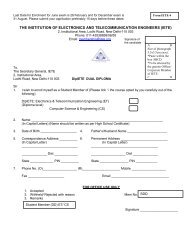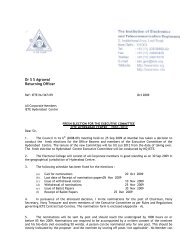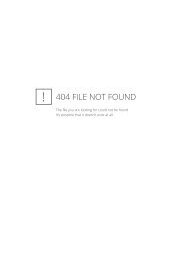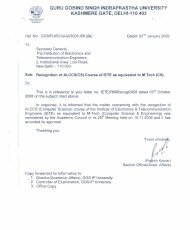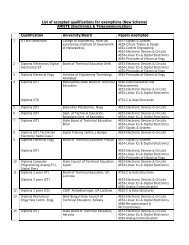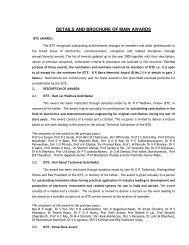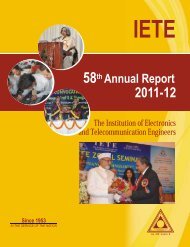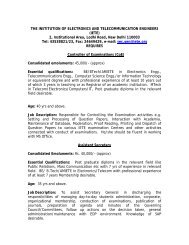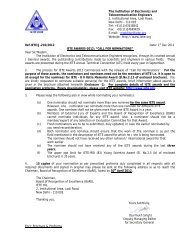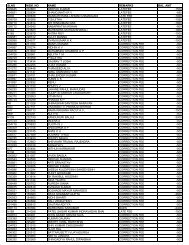You also want an ePaper? Increase the reach of your titles
YUMPU automatically turns print PDFs into web optimized ePapers that Google loves.
ALCCS – (NEW SCHEME)<br />
Code: CT22<br />
Subject: DISCRETE MATHEMATICAL STRUCTURES<br />
Time: 3 Hours Max. Marks: 100<br />
MARCH 2011<br />
NOTE:<br />
• <strong>Question</strong> 1 is compulsory and carries 28 marks. Answer any FOUR questions from<br />
the rest. Marks are indicated against each question.<br />
• Parts of a question should be answered at the same place.<br />
Q.1 a. Prove that p→(q→r) and (p∧¬r)→¬q are logically equivalent.<br />
b. In a survey, 2000 people were asked whether they read ‘India Today’ or ‘Business<br />
Times’. It was found that 1200 read ‘India Today’, 900 read ‘Business Times’ and<br />
400 read both. Find how many read at least one magazine and how many read<br />
neither.<br />
c. What is the minimum number of students required in a class to be sure that at least<br />
6 will receive the same grade if there are five possible grades A, B, C, D and F<br />
d. Determine whether the following is a valid argument:<br />
I am happy if my program runs. A necessary condition for the program to run is it<br />
should be error free. I am not happy. Therefore the program is not error free.<br />
e. Let m be a positive integer with m>1. Determine whether or not the following<br />
relation is an equivalent relation: R = {(a,b) a ≡ b (mod m)}<br />
f. Define Euler path, Euler circuit, Hamiltonian path and Hamiltonian circuit.<br />
g. Design a DFA for recognizing identifiers, unsigned integers and unsigned real<br />
numbers with fractions (7 × 4)<br />
Q.2 a. Consider the set A = {2, 7, 14, 28, 56, 84} and the relation a b if and only if a<br />
divides b. Give the Hasse diagram for the poset (A, ).<br />
b. Let L be a distributive lattice. Show that<br />
if a ∧ x = a ∧ y and a ∨ x = a ∨ y, then x = y for same a. (9+9)<br />
Q.3 a. Translate the following into logical notation. Let the universe of<br />
discourse be the real numbers.<br />
(i) For any value of x, x 2 is non negative.<br />
(ii) For every value of x, there is some value of y such that x.y=1.<br />
(iii) There are positive values of x and y such that x.y>0<br />
(iv) There is a value of x such that if y is positive, then x+y is negative.<br />
b. Minimize the following Boolean expression and give its DNF.<br />
CT22 / MARCH – 2011 1 ALCCS – NEW SCHEME
c. Determine the number of integers between 1 and 250 that are divisible by any of the<br />
integers 2, 3, 5 and 7. (8+7+3)<br />
Q.4 a. Convert the following proposition into polish prefix notation.<br />
(p → (q→r))≡(¬ (p∨ r)∧¬ q)<br />
b. If A⊆C and B⊆D, prove that A×B⊆C×D (9+9)<br />
Q.5 a. If G(V,E) is a simple connected planar graph, then 3v-6 ≥ e; where e is the total<br />
number of edges and v is the total number of vertices in the graph G. Use this to<br />
prove that complete graph K 5 is non planar.<br />
b. Let A = {1, 2, 3, 4} and, R = {(1, 1), (1, 4), (2, 1), (2, 2), (3, 3), (4, 4)}. Use<br />
Warshall’s algorithm to find the transitive closure of R. (8+10)<br />
Q.6 a. What is minimum spanning tree of a graph Execute Prim’s algorithm to find<br />
minimum spanning of the following graph (Fig. 1).<br />
b. Let A is a set of all positive real numbers and B is a set of all real numbers. Let f be a<br />
function f:A→B defined as f(x)=log e x. Show that f is one to one and onto function.<br />
(12+6)<br />
Q.7 a. Let L be a language over {0, 1} such that each string starts with a 0 and ends with a<br />
minimum of two subsequent 1’s. Construct,<br />
(i) the regular expression to specify L.<br />
(ii) a finite state automata M, such that M (L) = L.<br />
(iii) a regular grammar G, such that G(L) = L.<br />
b. Consider the following productions:<br />
S → aB bA<br />
A → aS bAA<br />
B → bS aBB<br />
a<br />
b<br />
Then, for the string a a a b b a b b b a, find the<br />
(i) the leftmost derivation.<br />
(ii) the rightmost derivation. (9+9)<br />
CT22 / MARCH – 2011 2 ALCCS – NEW SCHEME



